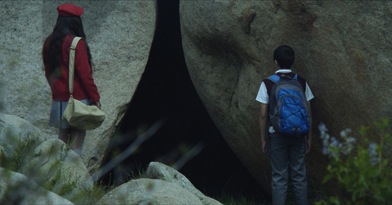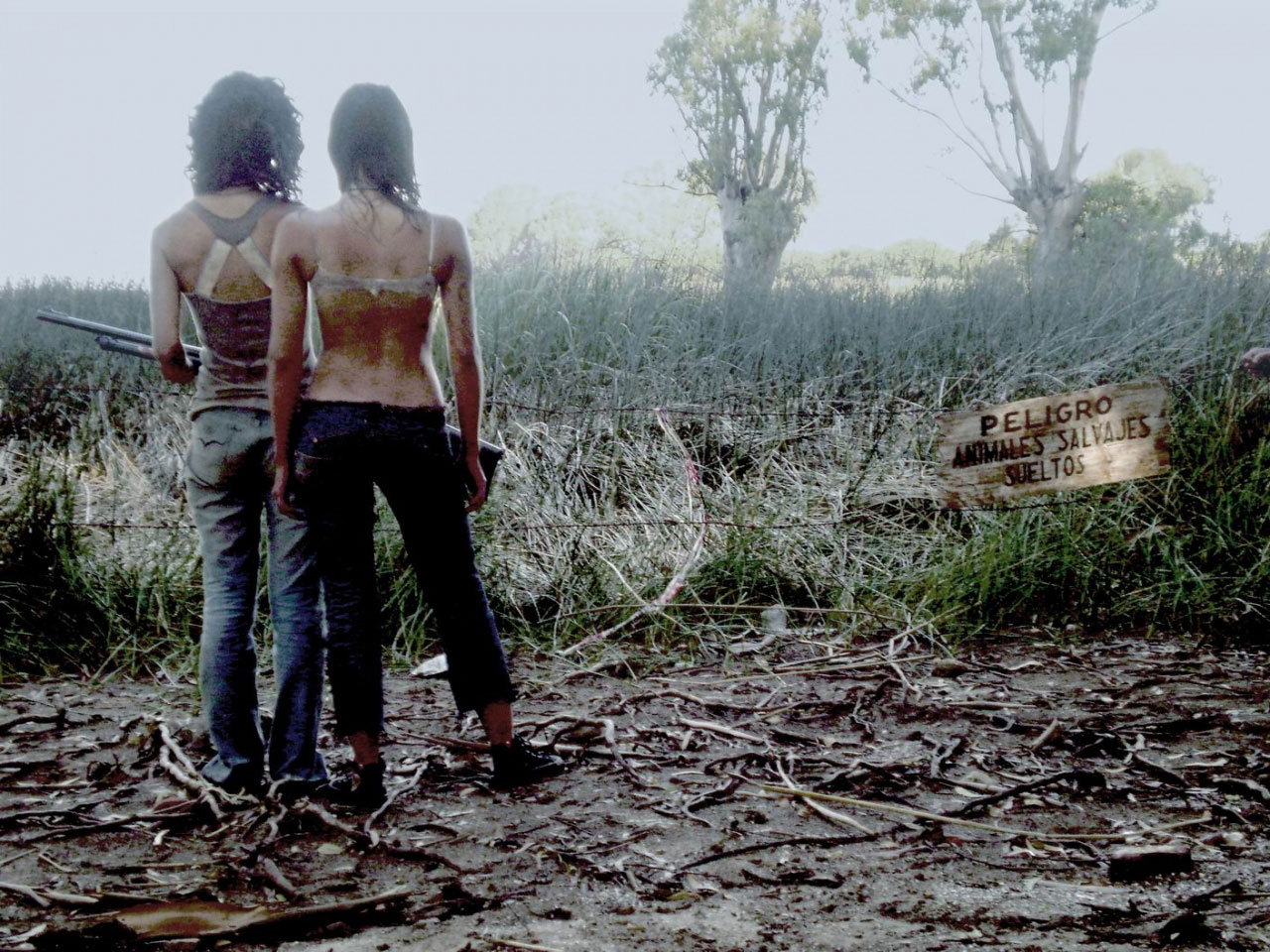Adrián García Bogliano is a maverick stylist. Born and raised in Spain, he resides in Argentina. As a young man looking to become a filmmaker he was heavily influenced by the movies of another stylist auteur, Brian De Palma, and as a writer/director he continues to refer to the movies of De Palma whenever he is about to make a new feature.
Bogliano’s latest however, Here Comes the Devil (2012); a dark, moody, supernatural affair set in Mexico, takes inspiration from one of Australia’s greatest contributions to the art of cinema, Peter Weir’s Picnic at Hanging Rock (1975), a deeply mysterious delve into the beyond, and the beyond’s insidious groping in return. Another influence on Bogliano’s tale of demonic abduction is the surreal, metaphysical works of yet another maverick stylist, Richard Stanley, who made the savagely dysfunctional sf Hardware (1990), and the tenebrous spiritual shenanigans of Dust Devil (1992).
Cult Projections: Where did the supernatural story for Here Comes the Devil originate?
Adrián: All these elements they have here in [the Mexican] culture. It was a very big change for me to see all these celebrations, Day of the Dead, all these things that are culturally different to what I am used to seeing in Argentina. In particularly, when we started thinking of shooting a film in Tijuana. Tijuana has all these stories about the devil, and these very strange things that have happened there, and it has a particular charm. It’s a very special city. When we started to talk about the idea of making a film there, I thought it had to be a supernatural film, and the funny thing is that I wrote this story and the basic reference was Picnic at Hanging Rock, but then I added this specific idea of some sort of demon, or entity that lives in this cave. And when we went to Tijuana and were scouting, we were scouting in a different location, somewhere that was very complicated to shoot, another series of caves and hills, and an old man pointed to a cave and told us that in that cave there was a story of a demon living there. So the same thing that happens in the film is also folklore, something they believed in.
CP: Atmosphere is one of the strongest elements in all of your movies. Roman Polanski once said that “atmosphere” is the most important element in a movie. How do you go about creating such a rich atmosphere, particularly on a low budget?
A: To me it all has to do with the cast. As much as possible I try to create interesting characters, or people you can relate to. For me, that is one of the biggest problems - mostly with horror films - that you can’t relate to the characters, so you can’t find anything interesting from those characters, and then you don’t care about what happens to them. But that’s pretty obvious really. That’s something that happens all the time on horror films. So I think the first thing is to create interesting characters, but more important than that is actors that can give more depth to those characters, and if you find that, then whatever they do will be interesting. So that’s the first basic thing: interesting characters, an interesting situation, and then, y’know, you can have more blood, less blood.
CP: You like improvisation, so how important is the screenplay and dialogue during shooting, compared to the story as a whole?
A: Well, y’know, I made my first movie [Rooms For Tourists (2004)], and it took me four years to make, and it was hell; it was really, really difficult. When I was finishing it I thought I would never direct another movie. There was a big economical crisis in Argentina in the meantime. One of the biggest problems was that I wanted everything to be exactly as I wrote it. Every single piece of dialogue, every single thing the script described had to be exactly as I imagined, and that’s why it took me so long. And then when I was finishing it I decided to go and shoot another movie for the sake of it, just find a bunch of actors, we had a thirty page script, and I just decided to go on and do it with whatever I had, with a bunch of great actors, and just find things I could use, and leaving a lot to the actors, allowing them to improvise, to do a lot of stuff, and that movie, Scream The Night (2005), was a very small film. That film gave me back the joy of shooting movies. So after that movie I always try to be very specific about what things are important for the movie, and I try to surround myself with creative people, and let them give me all they have. That’s very important to me.
CP: You often have beautiful women in peril - I suppose that’s the Brian De Palam influence coming through - what is it about the female gender that appeals to you as a filmmaker, so strongly?
A: That is something that started from my first film, and I made that kind of film for my first four films; Rooms For Tourists, Scream The Night, 36 Steps (2006), and I’ll Never Die Alone (2007). Those films are groups of women and their relationships. After that I started to make different things. But to me the relationships of the women were always very appealing, something that I always found fascinating; there were a lot of women surrounding me when I grew up. It was very appealing to me from a few movies of Dario Argento also, Phenomena (1984) or Suspiria (1977). But then I found a couple of years ago, when I came to Mexico for the first time, I found another director, Carlos Enrique Taboada, who made just horror films and all of them have just female characters. I found a lot of common elements between his ideas and mine, completely fascinating. It always happens, it’s not great, actually, it’s just the way it is; I start writing films where female and male characters have the same importance, but there is something along the process; either writing the script or making the movie, where the male character becomes less important, or less interesting than the female character. It actually happened on Here Comes The Devil. At a certain point the character of the husband becomes less interesting.
CP: I’ll Never Die Alone is one of your most powerful films. How important is sexuality in a horror movie?
A: To me it’s important in all of my movies; sexuality is always there. To me it’s as important as comedy is to some other horror directors. To add these comedy elements when you’re so concerned about death, so you give the audience a break with the comedic element, but to me it’s the sexuality. The sexuality represents more or less the same. Not always. It’s something that takes you away from that horror. Not in the case of I’ll Never Die Alone, of course. With I’ll Never Die Alone I wanted to make homage to these films of the 70s that really impressed me so much when I was a kid.
CP: What is the most disturbing movie you've ever seen and why?
A: I don't know which one is the most disturbing. I can think of the Spanish film Coto De Caz - the rape and revenge film by the director of The Living Dead at the Manchester Morgue - which was the first film that I remember being disturbed by. Then films like Funny Games, Unhinged, Irreversible, The Penthouse, or Sleepaway Camp. The last one that really disturbed me was Danny Steinmann's The Unseen. I didn't see it coming at all and I think that works better for me, when you think you know what you're seeing and then the movie surprises you and grabs you by your guts.
CP: Will you continue to make original low-budget horror movies? Do you think you’ll ever be seduced into directing a remake, or a big budget movie, or adapting a popular book?
A: I don’t know. I’m really comfortable doing these kinds of films. I’m working now with a bigger budget than I have in the past, so it’s more comfortable to try other things, but this is the place I feel better. If it was the right project, something interesting, I could try to do it, but I think that I will always come back to making these kinds of movies. I wouldn’t have an excuse to not be making movies. I’ve made movies for so little money that I think right now I can handle it again. Many directors think that they have to go bigger in terms of budget all the time. For some people it’s impossible to think about making a big movie and then doing something indie again, and I don't feel like that at all. I think the important thing is to keep making films, try to improve as a director each time, but not necessarily to translate that into bigger budgets, but into better movies.
Here Comes The Devil DVD is released by Accent Film Entertainment on February 19th 2014.





